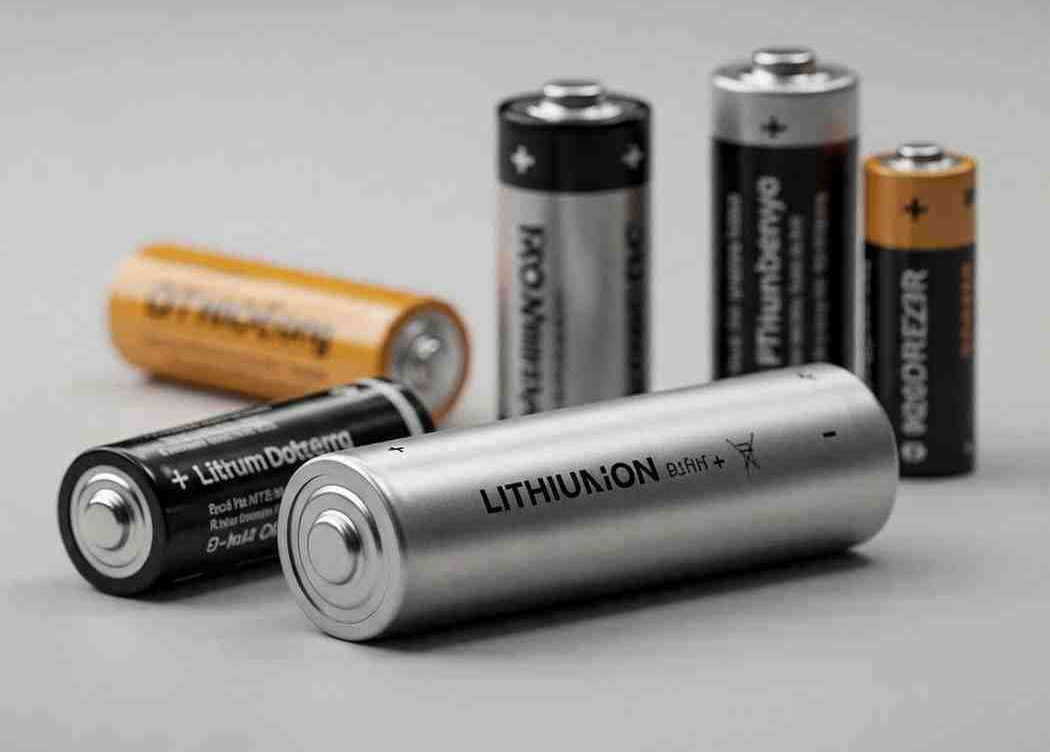
Top Battery Stocks in India (2025)
Top Battery Stocks in India (2025)
Energy Storage Industry in India
Fueled by a surge in renewable energy deployment and supportive governmental policies, India’s energy storage sector is undergoing substantial expansion. A notable achievement was the accumulation of 219.1 MWh of installed energy storage capacity by March 2024. Forecasts point towards an even more dramatic market escalation, anticipating a fivefold surge between 2026 and 2032, necessitating investments in the vicinity of ₹4.79 lakh crore (roughly $55 billion). This expansion is crucial for effectively integrating intermittent renewable energy sources into the power grid, thereby facilitating India’s transition towards cleaner energy.
Thank you for reading this post, don't forget to subscribe!Globally, the burgeoning energy storage industry is propelled by the increasing adoption of green energy and the rising popularity of electric vehicles. India’s ambitious commitment to achieving net-zero emissions by 2070 underscores the pivotal role of the battery sector in realizing this goal. This upward trajectory presents a considerable avenue for investors seeking to diversify their holdings with promising Indian battery stocks in 2025. While often overlooked in commonplace devices like remote controls, toys, and electric vehicles, batteries have become indispensable. India’s intensified focus on renewable energy has triggered a significant upswing in battery demand. As the nation progresses towards a more sustainable future, batteries are set to play a critical role in both energy infrastructure and transportation. The ensuing discussion will highlight leading battery stocks in India based on their investment returns and delve deeper into the dynamics of the Indian battery sector.
Top Battery Stocks in India for 2025
Identifying the top battery stocks requires a careful analysis of various factors, including the company’s market share, technological advancements, financial health, growth potential, and alignment with government initiatives. While the stock market is inherently dynamic and subject to change, several companies operating in the battery and related sectors in India are poised for significant growth in 2025.
Here is the list of top Battery Stocks in India
- Tata Chemicals Ltd: While primarily a chemical company, Tata Chemicals has made significant strides in the lithium-ion battery value chain, including active material manufacturing and battery recycling initiatives. Their strategic investments in this space position them well to capitalize on the growing demand.
- Amara Raja Energy & Mobility Ltd (formerly Amara Raja Batteries Ltd): A leading industrial and automotive battery manufacturer in India, Amara Raja is actively investing in advanced battery technologies, including lithium-ion batteries, and exploring opportunities in the EV and energy storage sectors. Their established market presence and diversification efforts make them a key player.
- Exide Industries Ltd: Another dominant player in the Indian battery market, Exide Industries is also focusing on developing and manufacturing lithium-ion batteries for automotive and industrial applications. Their extensive distribution network and brand recognition provide a strong foundation for growth in the evolving energy storage landscape.
- Reliance Industries Ltd: With its ambitious foray into clean energy, Reliance Industries has announced significant investments in battery manufacturing as part of its integrated renewable energy ecosystem. Their scale and financial muscle could make them a formidable player in the battery sector.
- Ola Electric Mobility Ltd: While not a publicly listed company as of now, there are expectations of a potential IPO in the future. As a leading EV manufacturer in India with its own battery cell manufacturing plans, Ola Electric’s stock could be a significant player in the battery segment if it goes public.
- Automotive Component Manufacturers (selectively): Certain automotive component manufacturers are also venturing into battery-related components or have collaborations in the battery supply chain. Investors should keep an eye on companies with strategic partnerships or dedicated divisions focusing on EV batteries.
(Please note that this is not financial advice, and thorough research is recommended before making any investment decisions. Stock performance is subject to market risks.)
Table of Contents
- Top Battery Stocks in India for 2025
- Best Battery Companies in India: An Overview
- What are Battery Stocks?
- Implications of Union Budget 2025-26 on the Energy Storage Sector and Battery Sector in India
- Key Features of Battery Sector Stocks
- Strategic considerations for battery sector stock performance
- Lithium-ion Battery Sector in India
- How the government is driving EV transformation
- Benefits of Investing in Battery Stocks in India
- The risks involved in buying battery shares
- Investing in India’s battery market: What you need to know
- Conclusion
Best Battery Companies in India: An Overview
The battery manufacturing industry in India is evolving rapidly. Traditionally dominated by lead-acid battery manufacturers catering to the automotive and industrial sectors, the industry is now witnessing the emergence of players focused on advanced battery technologies, particularly lithium-ion batteries. This shift is primarily driven by the growing demand for EVs and the need for grid-scale energy storage.
Established players like Amara Raja and Exide are adapting to this change by investing in R&D and establishing partnerships to manufacture lithium-ion batteries. Simultaneously, new entrants and companies from other sectors, such as Tata Chemicals and Reliance Industries, are setting up large-scale battery manufacturing facilities, aiming to capture a significant share of the burgeoning market. The competitive landscape is becoming increasingly dynamic, with collaborations, technology transfers, and a focus on localization of the supply chain gaining prominence.
What are Battery Stocks?
Battery stocks represent ownership shares in companies that are primarily involved in the research, development, manufacturing, and sale of batteries. These companies can range from those producing traditional lead-acid batteries to those specializing in advanced battery technologies like lithium-ion, sodium-ion, and solid-state batteries. Investing in battery stocks allows individuals to participate in the growth potential of the energy storage and electric mobility sectors. The performance of these stocks is often influenced by factors such as technological advancements in battery technology, government policies supporting EVs and renewable energy, raw material prices (like lithium, cobalt, and nickel), and the overall demand for energy storage solutions across various applications.
Implications of Union Budget 2025-26 on the Energy Storage Sector and Battery Sector in India
In line with India’s dedication to sustainable energy and self-sufficiency in vital technologies, the Union Budget 2025-26 includes several key initiatives expected to have a substantial impact on the nation’s battery sector and bolster the growth potential of battery stocks. These measures include the elimination of customs duties on waste and scrap of essential minerals such as lithium-ion batteries, cobalt, and copper, a move intended to ensure the availability of these crucial materials for domestic production, lessen reliance on imports, and stimulate the expansion of India’s battery manufacturing industry. Additionally, the government intends to introduce a policy focused on extracting critical minerals from mining by-products, a strategy anticipated to strengthen the domestic supply chain for battery manufacturing by utilizing previously untapped resources.
Key Features of Battery Sector Stocks
Investing in battery sector stocks comes with its own set of characteristics that investors should be aware of:
- High Growth Potential: The energy storage and EV markets are projected to experience significant growth in the coming years, offering substantial potential returns for investors in battery stocks.
- Technological Disruption: The battery technology landscape is constantly evolving, with new chemistries and manufacturing processes emerging. Companies that can innovate and adapt quickly are likely to outperform their peers.
- Policy Dependence: The growth of the battery sector is heavily influenced by government policies and regulations related to EVs, renewable energy, and domestic manufacturing. Changes in these policies can significantly impact the prospects of battery companies.
- Raw Material Price Volatility: The cost of key raw materials like lithium, cobalt, and nickel can fluctuate significantly, impacting the profitability of battery manufacturers.
- Long Gestation Periods: Setting up large-scale battery manufacturing facilities and achieving economies of scale can take time, meaning investors may need to have a long-term investment horizon.
- Supply Chain Dependencies: The battery supply chain is global, and companies may be vulnerable to disruptions in the supply of critical materials or components.
Strategic considerations for battery sector stock performance
Several strategic factors can influence the performance of battery sector stocks:
-
- Technological Leadership: Companies that invest heavily in R&D and possess proprietary or cutting-edge battery technologies are likely to have a competitive advantage.
- Supply Chain Integration: Securing access to raw materials through strategic partnerships, vertical integration, or diversification of sourcing can mitigate price volatility risks.
- Manufacturing Efficiency and Scalability: Companies that can manufacture high-quality batteries at scale and cost-effectively will be better positioned to capture market share.
- Strategic Partnerships and Collaborations: Alliances with EV manufacturers, energy storage developers, and technology providers can provide access to markets and expertise.
- Government Advocacy and Policy Alignment: Companies that actively engage with policymakers and align their strategies with government initiatives are likely to benefit from favorable regulations and incentives.
- Financial Strength: A strong balance sheet and the ability to fund capital-intensive projects are crucial for long-term success in the manufacturing sector.
- Focus on Sustainability and Recycling: With increasing environmental concerns, companies that prioritize sustainable manufacturing practices and invest in battery recycling technologies may gain a competitive edge.
Lithium-ion Battery Sector in India
The lithium-ion battery sector is at the forefront of India’s energy storage revolution. These batteries are the dominant technology for EVs and are also increasingly being used in grid-scale storage and portable electronics. The Indian government is actively promoting the domestic manufacturing of lithium-ion batteries through various initiatives, including PLI schemes, to reduce reliance on imports and build a self-sufficient ecosystem.
Several Indian companies are investing heavily in setting up lithium-ion cell manufacturing plants, while others are focusing on battery pack assembly, module production, and the manufacturing of key components and materials. The sector is attracting both domestic and foreign investment, with collaborations and technology transfers playing a significant role in building local capabilities. The focus is not only on manufacturing but also on developing a robust supply chain, including the sourcing and processing of raw materials and the establishment of battery recycling infrastructure.
How the government is driving EV transformation
The Indian government has implemented a multi-pronged approach to accelerate the adoption of electric vehicles:
- Financial Incentives: Schemes like the Faster Adoption and Manufacturing of Electric Vehicles (FAME) provide subsidies to EV buyers and incentives to manufacturers.
- Production-Linked Incentive (PLI) Schemes: These schemes offer financial rewards to companies investing in the manufacturing of EVs and their components, including batteries.
- Tax Benefits: Reduced GST rates on EVs compared to internal combustion engine vehicles make them more attractive to consumers.
- Development of Charging Infrastructure: The government is promoting the establishment of a nationwide charging infrastructure through policy support and financial assistance.
- Policy Support: Regulations and standards are being put in place to ensure the safety and quality of EVs and batteries.
- Awareness Campaigns: Initiatives are undertaken to educate the public about the benefits of EVs and encourage their adoption.
- Focus on Public Transportation: The government is promoting the electrification of public transport fleets, including buses and two-wheelers.
- State-Level Policies: Many states have also introduced their own policies and incentives to promote EV adoption and manufacturing.
These efforts are creating a favorable environment for the growth of the EV market, which in turn is driving the demand for batteries and supporting the growth of battery manufacturers in India.
Benefits of Investing in Battery Stocks in India
Investing in battery stocks in India offers several potential benefits:
- High Growth Potential: As discussed earlier, the energy storage and EV markets are poised for significant expansion, offering the potential for substantial capital appreciation.
- Alignment with Megatrends: Investing in battery stocks aligns with global trends towards clean energy, sustainability, and electric mobility.
- Government Support: Favorable government policies and incentives provide a supportive environment for the growth of the battery sector.
- Diversification: Battery stocks can offer diversification benefits to an investment portfolio, as their performance may not be perfectly correlated with traditional sectors.
- Contribution to a Sustainable Future: Investing in companies that are enabling the transition to cleaner energy can align with personal values and contribute to a more sustainable future.
- Potential for Innovation: The battery technology space is dynamic, and investing in companies that are at the forefront of innovation can yield significant returns.
The risks involved in buying battery shares
Despite the promising outlook, investing in battery stocks also involves certain risks:
- Technological Obsolescence: Rapid advancements in battery technology could make existing technologies or the products of certain companies obsolete.
- High Competition: The battery manufacturing sector is becoming increasingly competitive, which could put pressure on profit margins.
- Raw Material Price Volatility: Fluctuations in the prices of critical raw materials can significantly impact the profitability of battery manufacturers.
- Policy and Regulatory Changes: Changes in government policies related to EVs, renewable energy, or manufacturing incentives could negatively impact the sector.
- Long Gestation Periods and Capital Intensity: Battery manufacturing requires significant upfront investment and can have long payback periods, exposing investors to risks if projects face delays or cost overruns.
- Supply Chain Disruptions: Dependence on global supply chains for raw materials and components can lead to disruptions and impact production.
- Company-Specific Risks: Factors such as management quality, financial health, and execution capabilities can vary significantly between companies.
- Market Volatility: Like all stocks, battery stocks are subject to overall market sentiment and economic conditions.
Investors should carefully assess these risks and conduct thorough due diligence before investing in battery stocks.
Investing in India’s battery market: What you need to know
For investors looking to participate in India’s burgeoning battery market, here are some key considerations:
- Understand the Value Chain: The battery ecosystem includes raw material suppliers, cell manufacturers, battery pack assemblers, component manufacturers, and recycling companies. Understanding the different segments can help identify potential investment opportunities.
- Research Companies Thoroughly: Analyze the financial health, technological capabilities, market share, growth strategy, and management team of potential investment targets.
- Stay Updated on Government Policies: Keep abreast of the latest policy developments and incentives related to EVs and energy storage, as these can significantly impact the sector.
- Monitor Technological Trends: Follow advancements in battery technology, including new chemistries, manufacturing processes, and energy density improvements.
- Consider Diversification: Investing in a mix of battery-related companies across different segments of the value chain can help mitigate risk.
- Have a Long-Term Perspective: The energy transition and the growth of the EV market are long-term trends, so a patient investment approach is often advisable.
- Be Aware of Global Factors: Global trends in EV adoption, battery technology, and raw material availability can also influence the Indian battery market.
- Consult Financial Advisors: Seek advice from qualified financial professionals before making any investment decisions.
Conclusion
India’s energy storage and battery sector presents a compelling growth story driven by the country’s clean energy ambitions and the rapid adoption of electric vehicles. While the potential rewards are significant, investors must also be mindful of the inherent risks and conduct thorough research. By understanding the dynamics of the industry, the key players, and the influencing factors, investors can make informed decisions and potentially benefit from the transformative growth of India’s battery market in 2025 and beyond.
Disclaimer: This blog post is intended for informational purposes only and should not be considered financial advice. The financial data presented is subject to change over time, and the securities mentioned are examples only and do not constitute investment recommendations. Always conduct thorough research and consult with a qualified financial advisor before making any investment decisions.

